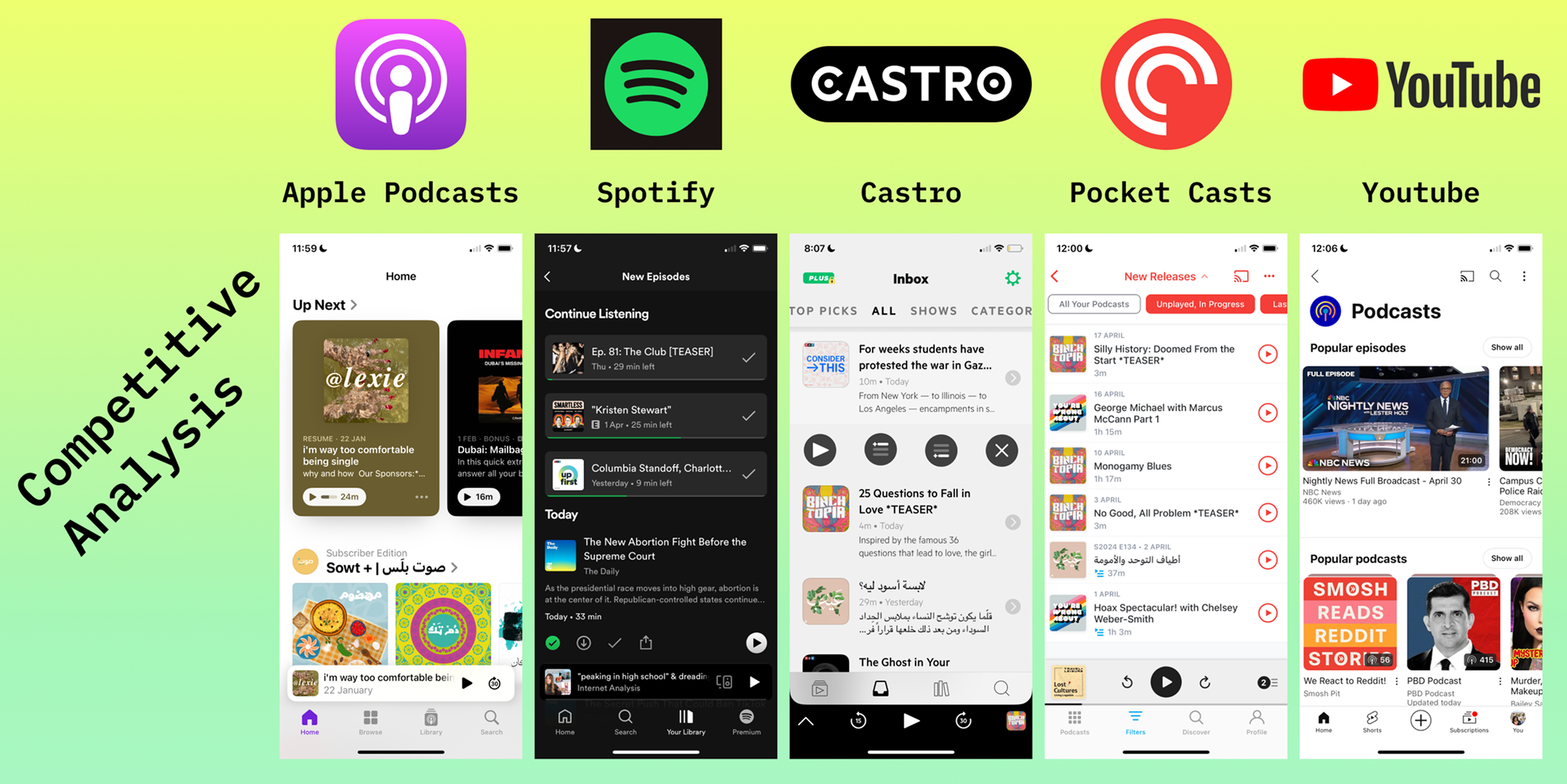Apple Podcasts
Adding a much-needed feature to Apple Podcasts to bring them up to par with their biggest competitor, Spotify.
Project background
|
Project background |
User Researcher, UX Designer, UI Copywriter
Role
Timeline
75 hours / 4 weeks
Constraints
Design must adhere to pre-established Apple branding
Problem
Currently, on Apple Podcasts, if you are listening to an episode but click on a different episode, your original episode disappears off the home screen.
Apple has no way of sorting favorite podcast episodes into a playlist. Both of these weaknesses can be addressed in order for Apple Podcasts to provide a better listener experience than Spotify.
The “Continue Listening” feature shows the user’s half-finished episodes on the homepage, which allows the user to easily go back to the podcast they had been listening to previously.
Create a “Playlists” feature within Apple Podcasts that allows users to sort and come back to their favorite episodes for a second listen.
Solution
Research Key Findings
Users I interviewed affirmed the need for the “Continue Listening” feature I had in mind. They mentioned appreciating how Spotify already has this feature.
Interviews revealed a surprising user behavior: some users actually re-listen to their favorite podcast episodes, some of them even becoming “comfort listens” the way one rewatches a favorite movie or tv show.
However, none of the major podcast apps boast a feature that allows users to organize their podcast episodes into playlists, which became the second feature I added to my prototype.
Defining the problem
|
Defining the problem |
User matrix
Those who listen to the podcast intently vs those who let it play in the background
Passive listeners do not like comments sections or social aspects as these require them to be more engaged
Passive listeners hate poor audio quality or having to listen in a loud environment (e.g. on the train), as this causes them to have to listen more intently
Active vs Passive listeners
Those who prefer pods without a narrative arc so they can listen to episodes in random order vs those who like to listen to a story
Episodic requires less investment (see below) than linear.
Episodic vs Serialized listeners
Those who listen to lots of pods and lightly engage vs those who are deeply invested in 1-4 pods, pay for their Patreons, follow the people on other social media, etc
Casual listeners demand top quality audio and always-engaging content
Invested listeners can give a little more leeway to poor audio every now and then since they are invested in the hosts themselves.
Casual vs Invested listeners
Designing a solution
|
Designing a solution |
Low fidelity wireframes
Usability testing
|
Usability testing |
Major flaws
The first two usability tests of my low fidelity wireframes revealed major design and functionality problems. I paused further testing and went back to creating a more functional prototype.
Higher fidelity
Following comprehensive feedback from my mentor and two testers, I brought the prototype up to a higher fidelity and prepared it for comprehensive usability testing.
Usability Test
With a functioning prototype, I tested five users on the following tasks:
Task 1: You are on the home screen listening to This American Life’s episode 840: Are You Not Seeing This. You are curious about another episode and click it, only to lose the original episode you’d been listening to. Please navigate back to episode 840 in at least two different ways.
Task 2: You are listening to an episode that you like. You decide you want to add it to your playlist of favorite episodes. Please go ahead and add this episode to your favorites playlist.
Results: 5/5 users were able to complete both tasks without error, within 1.5 minutes or less.
Conclusion
This was a quick project that uniquely challenged me to think within a pre-existing app’s brand. In the future, it would be interesting to interview more Apple Podcast users and survey people on the features they wish the app had. I’m also curious to dig deeper into the personas I created through the User Matrix and learn more about their needs for future projects.







